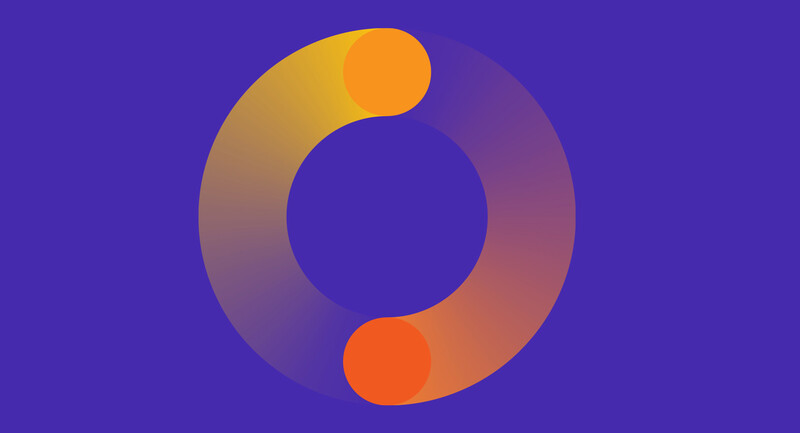CHALLENGE: Schools are stuck
in outdated
models.
In May 2021, as most schools were returning to in-person learning, I met online with a group of high school educators from Madison, Wisconsin. We were discussing the struggles of the full pandemic year, and what we needed to do as educators to move forward. There was a lot of talk about what went wrong that year: limited summer planning, start-and-stop returns to school buildings, the disaster of teaching students both in-person and online simultaneously. But I also asked what teachers thought had gone right. I'll never forget what one teacher told me.
"We know how to change," he said. "We've been changing every three weeks for 18 months."
Schools are conservative institutions, and our practices and policies often seem fixed and immovable. But at the height of the pandemic, so many things were up for grabs. We didn't use buildings, teachers snuggled their dogs between classes, students wore hoodies while learning, schedules were rearranged, breaks were added, requirements were removed. Teachers and their partners in school and district leadership brought a remarkable "can-do" attitude to making learning work in an ever-changing array of conditions.
Then we came back in person, and for too many educators, school feels stuck again. The "return to normal" feels like the normal that didn't work for so many children. Teachers still feel exhausted. Many students aren't quite back to the levels of engagement and connection that existed pre-pandemic; some kids aren't returning to school at all. It doesn't feel like the old normal can fix these challenges.
Given all this, how do we move forward? How do we harness the sense of possibility that so many teachers discovered during the pandemic? How do we rekindle the belief that we "know how to change" outside of an emergency?
The Someday/Monday Dilemma
One of the paradoxes of school change is that, for the most part, there are no big moves (outside of the rare global pandemic or Supreme Court desegregation case, of course). We aren't going to send all the kids home for a few months in the fall so faculty can have some peace and quiet while we retool everything. We can't put our schools in drydock; we can only change them while they are under sail. Under most circumstances, teachers can only make a few small changes on any given day.
I call this the Someday/Monday Dilemma. You and your colleagues can and should imagine big, sweeping changes—the "someday" dreams you want to accomplish. But the reality is, teachers will show up on Monday with six classes to teach, and all their change work has to fit into part of a prep period and a little bit of discretionary time in the mornings, after school, or, sometimes, in the evenings. The wide distance between our dreams and our constraints is emotionally hard on teachers and school leaders, who all want the best for students. The way to feel better is by making progress.
Schools are conservative institutions, and our practices and policies often seem fixed and immovable.
Solving the Someday/Monday dilemma requires finding a path to our big someday visions through lots of small Monday changes. You might not be able to switch to a year-long project-based curriculum tomorrow, for example, but could you add student choice around final assessment to your next unit? You can't switch the schedule to longer block periods tomorrow, but could your grade-level team pick one day to cancel the regular schedule and try out some block classes?
How Iteration Can Help
The secret to making big shifts through small moves is iteration: making things better and different through a steady commitment to continuous improvement. Over the past four decades, many sectors of American life have rethought how to make big change. We used to assume that big things start big. You want a massive new source of electricity? Drop the Hoover Dam into the Colorado River.
But the software revolution—programs, websites, mobile apps—has highlighted another pathway to big change: start small, iterate frequently, link small shifts to bigger changes, and commit to continuous improvement. For instance, the first YouTube video was 19 seconds of a developer looking at elephants in the San Diego Zoo. The crowdfunding site Kickstarter, which has profoundly changed funding for both small artistic projects and massive works in film and computer games, started with a project funded for $35. Three backers paid a user called "darkpony" to draw pictures, including one of "a half dragon man with a pitchfork and some skulls and he is flying toward a city to wreck it. and maybe he has some smaller dragonpeople sidekicks flying along side him" [sic]. From these small, incredibly compelling experiments, whole new fields of online video and artistic crowdfunding emerged. When they started, Kickstarter and YouTube didn't build everything they'd one day offer—likes, subscribers, updates, scalability, channels, and all the rest. They built one core thing, what software developers call the "minimum viable prototype." And then they updated those prototypes relentlessly. Each update followed a design cycle: understanding how people were using the prototype, testing new features, collecting data and measuring results, discarding false steps and amplifying productive changes. With many, many small updates, these two platforms made big changes in how we fund art (and other things), how we watch video, how we connect, and how we learn.
This approach to short cycles of design, improvement, and testing is sometimes called agile development, in contrast to more linear, planning-focused approaches. It's closely related to ideas that have found some footing in education: design thinking and human-centered design, along with improvement science and design-based implementation research. All these approaches try to shift improvement and reform to something continuous rather than episodic, from a time-limited event in the life of schools to an ongoing process. For schools to create shifts on their Someday/Monday journey, they need to embrace three kinds of change: From lines to spirals, long school plans to short cycles, and individual improvement to community partnerships. I'll explain more about each below.
Spirals and Cycles
First, when we imagine the future of our work, we should think about cycles and spirals instead of straight lines and linear narratives. School boards typically have five-year strategic plans with beginnings, middles, and ends; teachers have pacing guides that go from September to June. Linear narratives shape all kinds of thinking in education, and we need to reimagine those straight lines as spirals of improvement, with many iterative cycles of launching, evaluation, and tinkering. When we approach problems with linear thinking, we put finding problems at the beginning, developing solutions in the middle, and evaluation at the end. But often, when we start developing solutions and evaluating them, we find that we misunderstood the real problem to begin with. Spirals of improvement let us regularly return to the framing of our problems as we design and test new solutions. For example, schools across the country are still dealing with serious challenges of chronic absenteeism, and some powerful solutions to those challenges might require a long runway: hiring new staff or adopting new programs. But before making big investments in new staff or approaches, think about trying a smaller, spiral approach to the problem by testing new ways of reconnecting with just one child or family.
Shorter Design Cycles
The arc of school is so long: units take weeks, classes take months, schools take years. The system spans over a decade. It's incredibly hard to get better at something if you try it once in September and you don't get another shot at it until the next September. But if you can find ways to create design cycles that are shorter, you can experiment more with what works and what doesn't.
I got my start teaching in an unusual place. For a few years after college, I taught a two-day wilderness first-aid class to groups of college students, summer camp staff, traveling doctors and nurses, and special forces soldiers. It was a fun class: I'd lecture in the mornings about soft tissue injuries or fractures, and we'd go outside in the afternoon to practice fixing them. Students would "simulate" being patients with fake blood and bruises, while other students improvised bandages and splints from their backpacks.
For two years, I taught this same wilderness first-aid class over 100 times. Every time, I would try something just a little different. I'd introduce the topic with a new story. I'd use different materials for demonstrating an improvised splint. I'd tell the same joke that kept folks alert at slightly different points in the lesson sequence. I'd remember the questions that came up at the end of previous lessons and work the answers into a new lecture for the next lesson. I'd tweak the instructions to the students pretending to be patients for the simulations.
After each lesson, I'd reflect on how well I held students' attention, and what questions they asked or didn't. I talked with colleagues about what they observed and how we could do things differently. Perhaps most important, during the outdoor training scenarios, I walked from group to group and looked at their improvised splints and offered feedback. Right there, on the fake-injured leg of some now-smiling student, was the evidence of student learning and my teaching. Every lesson was an experiment, and over many iterations my teaching improved.
If you are an elementary school teacher, at some point during the year you might teach a lesson on how to write a sentence. You might teach that lesson, once per year, in October, and then not again until the following October. If you stay in the classroom for 25 years until you earn your pension, then you will have taught that lesson only 25 times over the course of an entire career.
With my short course, I taught the splinting lesson 25 times in just a few months. I was able to introduce a deliberate experiment, an intentional variation every time I taught, and rapidly improve my teaching.
If we are going to solve the Someday/Monday dilemma through lots of small changes, then we need to make more room in schools for these kinds of experiments. Before deploying a new semester-long class in data science, try it out as a two-week unit in a computer science class. Before you launch a new bell schedule for an entire year, try it for a week. Replace your normal schedule of classes with a different arrangement that might work better, or reinvigorate some dimension of teaching. (You think you can't change the schedule for a week? You did! Repeatedly during the pandemic!) Sequence together small iterative improvements, each step manageable on its own, each step evaluated on its own, so that they link to bigger changes.
Bring in Your Community
My third piece of advice for these Monday experiments is to work on them with colleagues and community members. Invite lots of people to join these design cycles with you. Students, colleagues, family members, and communities can all be involved in helping implement short spirals of design, evaluation, and improvement. Learning alone is hard! Improving alone is hard! Instead of imagining the improvement of teaching as the solitary quest of individuals, think of improved teaching as a community endeavor.
Instead of imagining the improvement of teaching as the solitary quest of individuals, think of improved teaching as a community endeavor.
One useful framing to bring into these conversations is a "how might we …" question. A how-might-we question imagines addressing a need without being overly prescriptive about a particular solution:
How might we create additional learning experiences for students who have many school absences?
How might we get more formative feedback from students, without so many graded assignments that are a major source of stress for them?
How might we increase the number of students with disabilities who are included in mainstream classes, without having teachers feel overwhelmed by the extra planning and differentiation?
When having these conversations and including our community in our design cycles, we should be particularly attentive to how marginalized folks in our communities—families who have recently arrived in the United States, students who experience discrimination, people who think and learn differently—can be powerful allies in creating better learning environments. When we include people on the margins with distinct assets and needs, we often find our way to designs that particularly benefit targeted students and families while generally benefiting everyone in a community.
Let Me Reiterate …
Lines to spirals, long school plans to short cycles, individual improvement to community partnerships. When you figure out how to make iteration central to your teaching, you'll improve faster, your community will benefit from your improvements, and you'll find that teaching is more fun and more energizing. It's one way to start getting unstuck from models that feel outdated or no longer relevant.
As educators, we made many of these changes during the pandemic—lots of small shifts from one class to the next to make online and hybrid learning go from impossible to manageable. We know how to change. The opportunity we face is discovering how we can take that sense of possibility and urgency we found during the pandemic and apply that same energy and inventiveness to the new challenges of post-pandemic schools.
Reflect & Discuss
➛ Think of a "someday" dream about your school, classroom, or practice. What's one small change you can make next week to head toward that goal?
➛ What is a "how might we" question that can spark a conversation about your someday goal? Who in your school or community would be valuable to bring into that discussion?
Getting to Someday with Mondays
It can feel overwhelming as an educator to make big changes, but to get to your "someday" dreams, you have to start with small "Monday" steps. Here are a few ideas:
Think of one step that you can do by yourself in the next two weeks.
Maybe it's as simple as setting up appointments with colleagues you would like to work with.
Decide where input and help from others in your community is likely necessary or desirable.
Perhaps you share an email about your idea with a colleague and ask them about feedback for your next steps—or even better, next steps you can take together. You can't make change alone; partnerships and collaborations are essential.
Write out an idea for engaging with students as co-creators.
Ideally, students should play a large role in all phases of your initiative.
Describe an experiment around your problem of practice.
This doesn't have to be huge or complex. If you're a teacher, maybe you present content in a different way. If you're an administrator, perhaps you encourage the sharing of student work among teachers in your department. The sooner you can get started trying things, the better.
Consider the possible impact/result of the steps you wrote about.
As you think through each Monday step, take a minute to write down what you think will happen, and how people will respond.
Breaking the Mold
This online database can spark unique ideas about new school models.
Sometimes to do something completely new, we need to build on inspiration from existing frameworks.
The Innovative Models Exchange provides innovative school case studies to help educators break out of traditional ways of thinking and improve learning for all students. Created by the nonprofit Transcend, the website has more than 50 searchable innovative school models from institutions across the country. Each profile includes an overview, information about the design, guides for implementation, and further resources.
The database offers collections to help educators focus on a specific model they are interested in, such as advisory, blended learning, project-based learning, and high-dosage tutoring. Users can also browse by model or search for keywords.
"Despite innovation across nearly every sector of society, schooling in America operates largely the same way it did a century ago," write the website's creators. "We believe sharing and learning from promising models is critical to school innovation and improvement."









